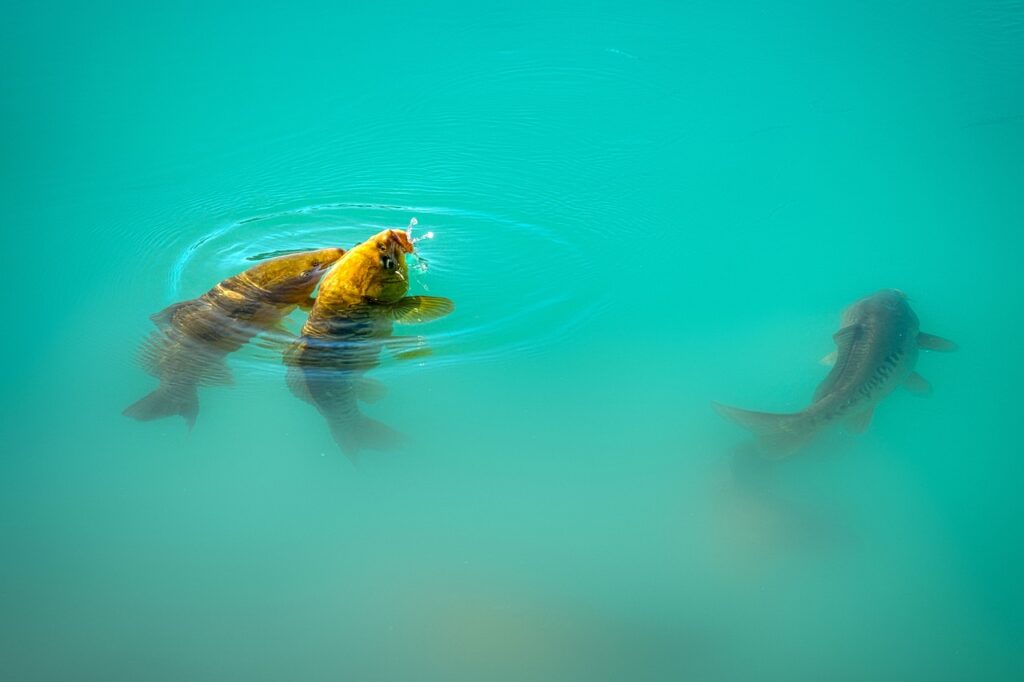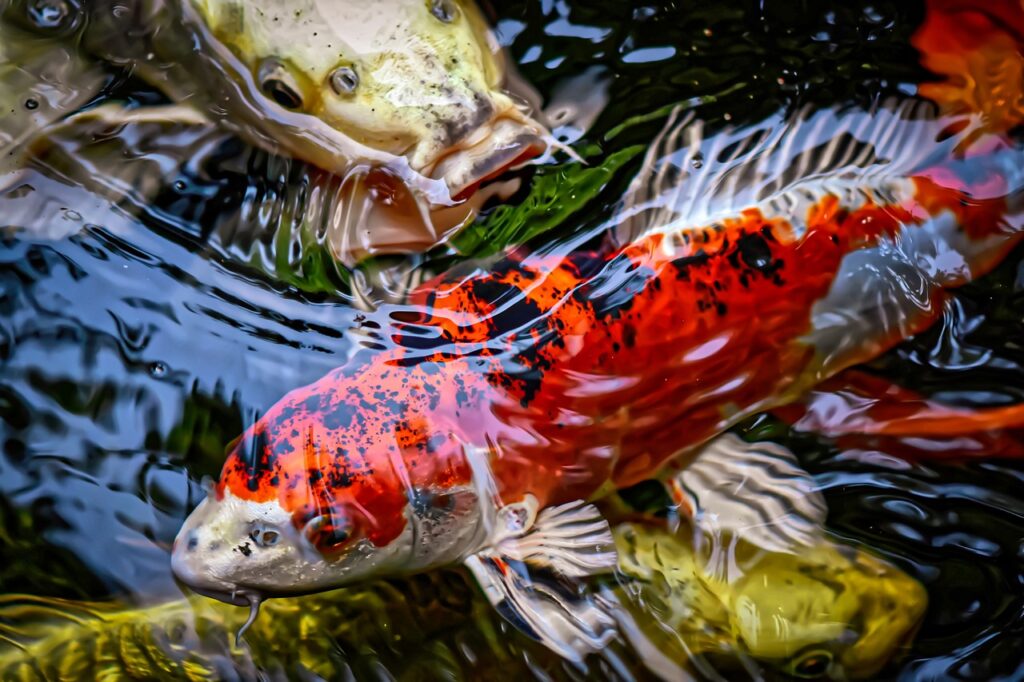As a pond owner and fish keeper, have you ever wondered the dynamics of how often should fish pond water be changed? Maintaining proper water quality is crucial for the health and longevity of your fish.
Today, we will explore the importance of changing fish pond water and provide you with some guidelines on how often you should do it. So, grab yourself a cup of coffee, and let’s dive into the fascinating world of fish pond maintenance!
Factors Affecting Frequency of Water Changes
Size of the Fish Pond
The size of the fish pond plays a significant role in determining the frequency of water changes. Larger ponds have a higher volume of water, which means they can dilute pollutants more effectively. Therefore, they generally require fewer water changes compared to smaller ponds.
Number and Size of Fish
The number and size of fish in the pond directly affect the water quality. As fish produce waste, more fish in the pond mean a higher accumulation of pollutants. Additionally, larger fish generate more waste, leading to the need for more frequent water changes to maintain optimal water conditions.
Filtration System
The efficiency and capacity of the filtration system in the fish pond greatly impact the frequency of water changes. A well-designed and properly maintained filtration system can effectively remove waste and other pollutants, reducing the frequency of water changes required. On the other hand, an inadequate or malfunctioning filtration system may necessitate more frequent water changes to keep the water clean and clear.
Amount of Vegetation
The presence of plants in the fish pond can influence the need for water changes. Plants help to absorb nutrients and discourage excessive algae growth, leading to improved water quality. If the pond has a substantial amount of vegetation, water changes may be less frequent as plants contribute to maintaining a balanced ecosystem.
Water Quality Testing
Regular testing of the water quality is essential in determining the need for water changes. Monitoring parameters such as ammonia levels, pH, nitrate levels, and oxygen content can help identify when the water conditions are deteriorating. Based on the test results, adjustments can be made to the frequency of water changes to ensure that the pond remains healthy and suitable for the fish.
Signs that Indicate the Need for Water Changes
Cloudy or Murky Water
Cloudy or murky water is often a sign of excessive organic matter and suspended particles in the pond. If the water appears hazy and lacks clarity, it indicates the need for a water change. Fresh, clean water will help restore the pond’s clarity and improve the overall health of the fish.
Excessive Algae Growth
A proliferation of algae in the fish pond can indicate an imbalance in the water’s nutrient levels. Algae thrive in water with high levels of nutrients and sunlight. If the pond becomes overrun with algae, it is a clear indication that a water change is required to restore the ecological balance and prevent potential harm to the fish.
Unpleasant Odor
A foul or unpleasant odor emanating from the pond may be a result of decomposing organic matter or excessive waste accumulation. This odor is a clear indication that the water quality has deteriorated and a water change is necessary to eliminate the source of the smell and maintain a healthy environment for the fish.
Visible Debris Accumulation
If you notice a significant accumulation of debris such as leaves, twigs, or excess fish food in the pond, it is an indication that the water is not being effectively filtered or circulated. Regular water changes are necessary to remove this debris and prevent it from decomposing and polluting the water.
Unbalanced Water Parameters
Changes in water parameters such as high ammonia or nitrate levels, pH fluctuations, or insufficient oxygen may indicate an unbalanced ecosystem. Water changes can help restore the ideal water parameters for the fish’s well-being and prevent potential health problems.

General Guidelines for Water Change Frequency
Small Fish Ponds (less than 1000 gallons)
For small fish ponds with a capacity of less than 1000 gallons, it is generally recommended to perform partial water changes every 1-2 weeks to maintain water quality. Monitoring the signs mentioned above and conducting regular water quality tests will help determine the exact frequency required for each specific pond.
Medium-sized Fish Ponds (1000-5000 gallons)
Medium-sized fish ponds, ranging between 1000 and 5000 gallons, typically require partial water changes every 2-3 weeks. However, this frequency can vary depending on factors such as the number and size of fish, the efficiency of the filtration system, and the presence of vegetation.
Large Fish Ponds (over 5000 gallons)
In larger fish ponds exceeding 5000 gallons, partial water changes can be performed every 3-4 weeks. Due to the larger volume of water, these ponds have a higher dilution capacity, allowing for fewer water changes. However, it is crucial to closely monitor water quality and adjust the frequency accordingly.
Procedure for Changing Fish Pond Water
Prepare Necessary Equipment
Before starting the water change process, gather the necessary equipment. This may include a siphon or pump for water removal, a net or bucket to temporarily hold the fish, a water conditioner to treat the new water, and a testing kit to monitor water parameters.
Partial Water Changes
Partial water changes involve removing a portion of the existing water and replacing it with fresh, conditioned water. Begin by using a siphon or pump to drain approximately 20-30% of the pond water into a suitable draining area. Take care not to disturb the fish or stir up debris during this process.
Complete Water Changes
Complete water changes entail removing the entire volume of water from the pond and replacing it with fresh water. This method is generally reserved for specific circumstances, such as severe water quality issues or disease outbreaks. Complete water changes should be undertaken with caution, taking into consideration the stress it may cause to the fish and the need to reestablish beneficial bacteria.

Importance of Partial Water Changes
Preventing Ammonia Buildup
Ammonia is a toxic substance released by fish waste and decaying organic matter. Regular partial water changes help reduce ammonia levels in the pond, preventing its buildup and maintaining a healthy environment for the fish. Elevated ammonia levels can lead to stress, illness, and even death of the fish.
Maintaining Stable Water Parameters
Partial water changes contribute to stabilizing water parameters, such as pH, temperature, and oxygen levels. By replenishing a portion of the water with fresh, conditioned water, the pond’s stability is preserved, minimizing stress on the fish and promoting their overall well-being.
Minimizing Stress on Fish
The process of water changes can be stressful for fish, especially if performed incorrectly or too frequently. Partial water changes allow for a gradual transition and help minimize the stress on the fish. Sudden and drastic changes in water parameters can be harmful and potentially fatal, making partial water changes a crucial aspect of fish pond maintenance.
Tips for Conducting Water Changes
Use a Siphon or Pump for Easy Removal
Investing in a siphon or pump for water removal makes the process of partial water changes much more convenient. These tools allow for efficient and controlled removal of water, minimizing disturbance to the fish and reducing the risk of stirring up debris.
Conditioning Tap Water
Tap water often contains chlorine or chloramines, which can be harmful to fish. Before adding fresh tap water to the pond, it is essential to use a water conditioner specifically designed for fish ponds. This will neutralize any harmful substances and ensure the water is safe for the fish.
Avoid Draining the Entire Pond at Once
Unless necessary, complete water changes should be avoided as they can disrupt the pond’s ecosystem and cause unnecessary stress to the fish. Draining the entire pond should only be done in extreme cases where water quality is severely compromised and other solutions have failed to address the issue.
Monitor Water Parameters After Changes
After conducting water changes, it is crucial to monitor the water parameters closely for any changes. Testing ammonia, nitrate, pH, and oxygen levels will help ensure that the water conditions remain optimal for the fish. Adjustments may need to be made to the water change frequency or other aspects of the pond maintenance based on the test results.

Benefits of a Regular Water Change Routine
Removing Nitrate Accumulation
Nitrate, produced through the breakdown of waste, can accumulate in the pond over time. Regular water changes help dilute and remove excess nitrate, maintaining a healthy balance in the water. Excessive nitrate levels can negatively impact fish health and contribute to algae blooms.
Improving Fish Health and Growth
Clean, fresh water is essential for the overall health and growth of the fish. Regular water changes remove toxins, waste, and pollutants, reducing the risk of disease and improving the fish’s immune system. Healthy fish are more likely to exhibit vibrant colors, active behavior, and optimal growth.
Enhancing Water Clarity
Water changes play a significant role in improving the clarity of the pond. By removing suspended particles, excess debris, and other impurities, water changes promote clear, visually appealing water. Additionally, maintaining water clarity allows for better visibility of the fish and their interactions.
Preventing Algae Blooms
Algae blooms occur due to an imbalance of nutrients in the pond water. Regular water changes help maintain appropriate nutrient levels, preventing excessive algae growth. By controlling algae blooms, the overall health and balance of the fish pond can be preserved.
Challenges and Precautions to Consider
Temperature Differences
During water changes, significant temperature differences between the new water and the pond water can stress the fish. To avoid temperature shock, it is advisable to match the temperature of the new water as closely as possible to the existing water. This can be achieved by allowing the replacement water to sit at a similar temperature for some time before adding it to the pond.
Maintaining Beneficial Bacteria
Beneficial bacteria in the fish pond play a crucial role in the nitrogen cycle, breaking down harmful ammonia into less toxic nitrate. Complete water changes can disrupt the balance of these beneficial bacteria, potentially causing ammonia spikes. If a complete water change is necessary, it is crucial to add a bacterial supplement to reintroduce these essential microorganisms.
Avoiding Excessive Stress on Fish
While water changes are necessary for maintaining a healthy fish pond, it is important to minimize stress on the fish during the process. Handle fish with care and avoid overcrowding them in temporary holding containers. Take the necessary precautions to ensure a smooth and stress-free water change routine.
Consulting Professionals and Expert Advice
Local Fish Pond Specialist
Seeking advice from a local fish pond specialist can provide valuable insights into the specific requirements of your pond. They can assess the pond’s conditions, recommend appropriate water change frequencies, and offer guidance on any specific challenges or requirements unique to your pond.
Aquatic Veterinarian
If you encounter persistent health issues or unusual behavior in your fish, consulting an aquatic veterinarian is recommended. They can perform tests, diagnose any potential diseases or infections, and provide tailored advice on water changes and other necessary treatments.
Online Forums and Communities
Participating in online forums and communities dedicated to fish pond enthusiasts can be a great source of knowledge and advice. Interacting with experienced hobbyists and professionals in these communities can provide diverse perspectives and solutions to common problems encountered in fish pond maintenance.

How Often Should Fish Pond Water Be Changed
Balancing water change frequency with individual pond needs is vital for the health and thriving ecosystem of a fish pond. Factors like pond size, fish population, filtration system, vegetation, and water quality testing contribute to determining the optimal frequency for water changes.
Recognizing signs such as cloudy water, excessive algae growth, unpleasant odor, debris accumulation, and unbalanced water parameters helps indicate when water changes are necessary. By following general guidelines and procedures, utilizing partial water changes, and considering the importance of maintaining stable water parameters, fish pond owners can ensure the well-being and growth of their fish.
Regular water changes bring various benefits, including removing nitrate accumulation, improving fish health and growth, enhancing water clarity, and preventing algae blooms. Overcoming challenges such as temperature differences, maintaining beneficial bacteria, and minimizing stress on fish requires careful consideration and precautionary measures.
Seeking professional advice from local specialists, aquatic veterinarians, and online communities can provide additional support and guidance. By staying attentive to fish behavior and water quality, pond owners can create a healthy and thriving environment for their beloved fish. Also, keeping yourself up to date with knowledge, such as ‘What Plants Oxygenate A Fish Pond Naturally‘ will also help you.
